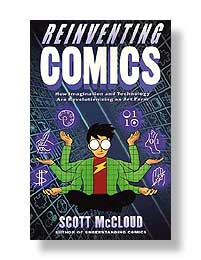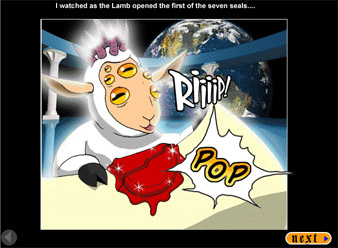If you want to learn how to draw comics you can go to the art section of any bookstore and pick up books that will tell you how to draw the marvel way, how to draw manga, how to draw cutting edge comics, how to draw villains, women, horror, military, etc. But drawing characters is different than making comics. Will Eisner was the generator of the term ‘sequential art’ and the first popular theory of comics. Scott McCloud is his recent successor. Eisner created the vocabulary of sequential art in his long-running course at the School of Visual Arts in NYC. McCloud helped a generation of comic book readers grasp that vocabulary in Understanding Comics, by creating a graphic novel that employed comic art to explain comic theory. But both Eisner and McCloud wrote about a time when comic delivery was bound to newspapers and twenty-two page glossy, stapled pages.

Whither the network? McCloud treats the possibilities of the Internet in his second book, Reinventing Comics, but mostly as a distribution mechanism. We shouldn’t overlook the powerful affect the ‘net has had on individual producers who, in the past, would have created small runs of photocopied books to distribute locally. Now, of course, they can put their panels on the web and have a potential audience of millions. Some even make a jump from the web into print. Most web comics are sufficiently happy to ride the network to a wider audience without exploring the ‘net as vehicle to transform comics into uniquely non-print artifacts with motion, interactivity, sound.
But how might comics mutate on the web? At the recent ITP Spring show I saw a digital comics project from Tracy Ann White’s class. The class asks the question: “What happens when comics evolve from print to screen? How does presentation change to suit this shift?” Sounds like familiar territory. White, a teacher at ITP, has been a long time web comic artist (one of the first on the web, and certainly one of the first to incorporate comments and forums as part of the product.
When I did a little research on her, I found an amazing article on Webcomics Review discussing the history of web comics. (There’s also more from White there.) There has been some brilliant work done, making use of scrolling as part of the “infinite canvas,” but more importantly, work that could have no print analog due the incorporation of sound and motion. The discussion in Webcomics Review covers all of the transformative effects of online publishing that we talk about here at the Institute: interlinking, motion, sound, and more profoundly, the immediacy and participative aspects of the network. As an example, James Kochalka, well known for his Monkey vs. Robot comics and a simplistic cartoon style, publishes An American Elf. The four panel personal vignette is published daily-blogging with comics.

Other ground breaking work: Nowhere Girl by Justine Shaw, a long form graphic novel that proved that people will read lengthy comics online. Apocamon by Patrick Farley, is a mash up of Pokemon and The Book of Revelations. There is a well known series of bible stories in comic strip format – this raises that tradition to the level of heavenly farce (with anime). Apocamon judiciously uses sound and minor animation effects to create a rich reading experience, but relies on pages—a mode immediately familiar to comic book readers. The comics on Magic Inkwell (Cayetano Garza) use music and motion graphics in a more experimental way. And in Broken Saints we find an example where comic conventions (words in a comic style font, speech bubbles, and sequential images) fade into cinema.
As new technology enables stylistic enhancements to web comics, the boundaries between comics and other media will become more blurred. White says, “In terms of pushing interactive storytelling online games are at the forefront.” This is true, but online games dispense with important conventions that make comics comics. The next step for online comics is to enhance their networked and collaborative aspect while preserving the essential nature of comics as sequential art.
if:book
A Project of the Institute for the Future of the Book

Do you know the BD blog phenomenon ? It’s far away from interactive technologies you noticed, but i think it is very usefull to see colaborative aspect beetween authors of comics and public.
Some famous french BD Blog :
http://www.melakarnets.com
tempsperdu.over-blog.org
http://www.lewistrondheim.com/blog
http://ciboulette.fr/blog/
…
See a lot of blogs links in their blogroll.
At the risk of sounding shamelessly self-promoting, I’ve recently released the first issue of a graphic novel series entitled Chasing The Wish, that is the first attempt I’m aware of to combine the comic book format with an immersive and interactive online fictional reality. The narrative told by the graphic novels is fully integrated with and enhanced by an online alternate reality game, featuring 18 fictional websites, multimedia assets, real world items and events, and dozens of interactive characters created exclusively for the project. While both the comic and the online game could be enjoyed as separate entities, they also combine to tell one overarching meta story.
You can also read more about the project here.
there’s some excellent work there, dave!
i’ve been waiting for many, many years
for creative individuals to start
pushing the envelope on storytelling,
using new capabilities at their disposal,
and — as evidenced by dave here and
a few pioneering experiments elsewhere —
it looks like that time has finally come.
enjoy your sandbox and the game you have
started to play, dave!
-bowerbird
ARComics.com is a pretty neat twist to the digital comic book. They have an animated comic book using flash for the web and the Sony PSP. It’s neat and looks promising.